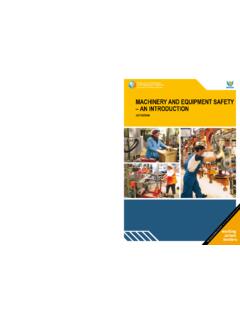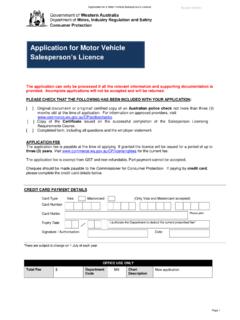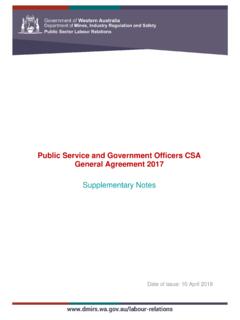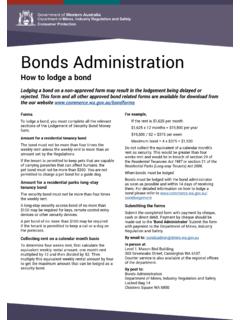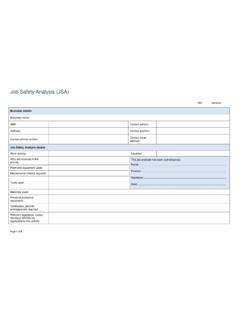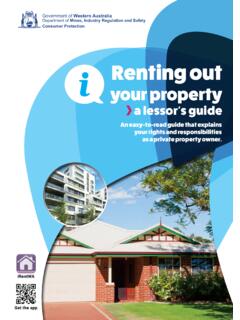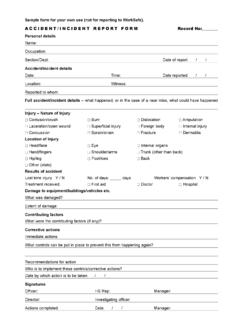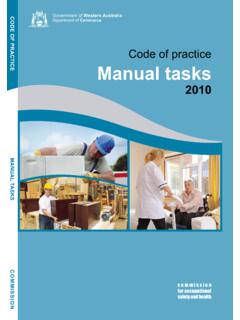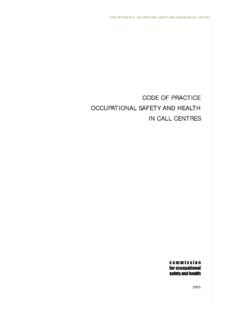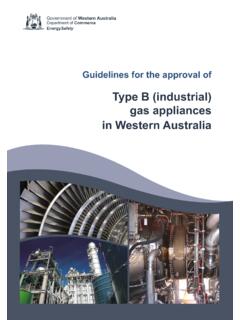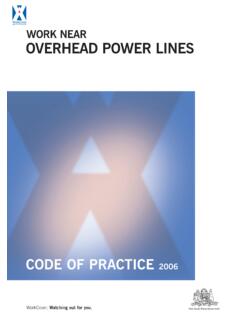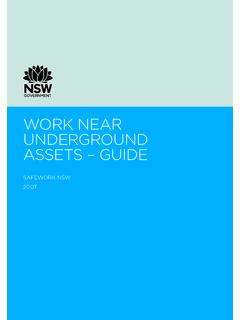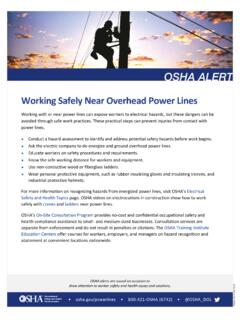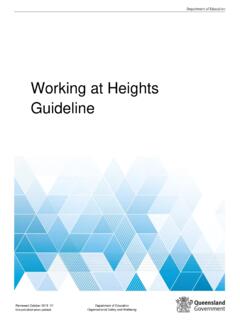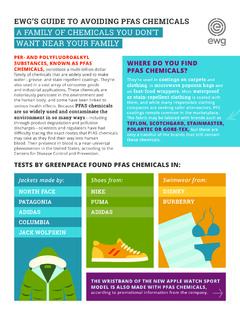Transcription of Code of Practice for persons working on or near energised …
1 Code of Practice for persons working on or near energised electrical installations Issued by the Director of Energy Safety November 2017 2 Code of Practice for persons working on or near energised electrical installations Preface EnergySafety has developed this Code of Practice for persons working on or Near energised electrical Installations (the Code). The Code commences on the day the Electricity (Licensing) Amendment Regulations (No. 2) 2017 commences. Compliance with the Code is made mandatory by Regulation 49(1) of the Electricity (Licensing) Regulations 1991. A downloadable copy of the Code is available from EnergySafety s website at Ken Bowron Director of Energy Safety November 2017 Code of Practice for persons working on or near energised electrical installations Contents 1. Scope of this Code.
2 4 2. Definitions .. 5 3. Responsibilities .. 5 4. Work on electrical installations de- energised work .. 6 Procedure for 6 Risks when fault finding and testing on de- energised equipment .. 6 5. Carrying out electrical work on or near energised electrical installations .. 7 Summary of requirements before electrical work is carried out on or near energised electrical installations .. 7 Risk assessment .. 7 Typical risks when carrying out electrical work on or near energised electrical installations .. 8 Hazards indirectly caused by electricity conductive materials .. 8 Arc Flash Hazard .. 9 Risks when fault finding and testing on energised equipment .. 9 Further guidance on the Risk Assessment Process .. 9 Assessment by the competent person .. 10 Safe work method statement (SWMS).
3 10 Tools and equipment .. 11 Training of electrical workers on testing .. 11 Personal protective equipment (PPE) .. 11 Safety barriers .. 12 Safety signs .. 12 Safety observers .. 12 Completion of work .. 13 Leaving work unfinished .. 13 Emergency planning .. 14 Appendix A Safe Work Method Statement Template .. 15 Appendix B Decision Flowchart Work on or near energised electrical installations .. 17 4 Code of Practice for persons working on or near energised electrical installations 1. Scope of this Code Regulation 55 of the Electricity (Licensing) Regulations 1991 prohibits electrical work on or near an energised part of an electrical installation except under certain specific situations prescribed in Sub-regulation 55(2). This Code prescribes additional requirements for those persons who will be authorising or carrying out electrical work on or near energised electrical installations.
4 It is to be read in conjunction with the Occupational Safety and Health Regulations 1996 (OSHR), in particular Part 3 Division 6. Compliance with the Code may be achieved by following another method utilising sound risk management practices, if it provides an equivalent or higher standard of electrical safety than the Code. The Code applies to all electrical work on low-voltage and high-voltage installations. It does not apply to work on extra-low voltage1 electrical equipment. Regulation 55 does not apply to a network operator s network but does apply to electrical installations that are not part of the network operator s network such as general power and lighting in switchyards and associated control buildings. This Code has been made in accordance with Part VI of the Interpretation Act 1984 and has the power of subsidiary legislation.
5 It is referenced in Regulation 49(1) of the Electricity (Licensing) Regulations 1991. 1 Voltages that do not exceed 50 volts or 120 volts ripple-free 5 Code of Practice for persons working on or near energised electrical installations 2. Definitions The following terms used in this Code have the same meaning as those terms in the Electricity (Licensing) Regulations 1991: de- energised has the meaning given in Regulation 3; electrical installation has the meaning given in Regulation 3; energised has the meaning given in Regulation 3; electrical work has the meaning given in Regulation 4A; near has the meaning given in Sub-regulation 54A(2); written form includes retrievable electronic records. The term competent person used in this Code has the meaning given in Regulation of the Occupational Safety and Health Regulations 1996: competent person, in relation to the doing of anything, means a person who has acquired through training, qualification or experience, or a combination of those things, the knowledge and skills required to do that thing competently.
6 3. Responsibilities The following persons are collectively responsible for ensuring that electrical work is carried out under de- energised conditions in all circumstances except as permitted by Regulation 55: 1. A person carrying out electrical work; 2. An electrical contractor or in-house electrical installing work licence holder; 3. A person who, at a workplace, is2: an employer; the main contractor; a self-employed person; a person having control of the workplace; or a person having control of access to the workplace. 2 See Occupational Safety and Health Regulations 1996 for the definition of the listed persons . 6 Code of Practice for persons working on or near energised electrical installations 4. Work on electrical installations de- energised work Procedure for de-energising The most effective safety control measure is to de-energise the relevant part of the electrical installation and to ensure the work is not carried out near any part of the installation that remains energised .
7 Before any electrical work is undertaken, the responsible person must ensure the electrical installation or the relevant part of the electrical installation to be worked on: a. is tested by a competent person to ascertain whether or not it is energised ; and b. if it is found to be energised , is de- energised by a competent person. To effectively de-energise the electrical equipment or circuit to be worked on, the following procedural steps should be taken in the order shown: 1) Identify the circuit to be worked on and verify it is the correct circuit by testing do not rely on labels or other means. 2) Disconnect all supplies of electricity to the installation , or that part of it to be worked on, by opening the necessary switches and/or removing fuses and links. There might be multiple network connections, standby generators, solar panels, batteries, back-up supplies or uninterruptable power supplies from other parts of the installation .
8 3) If work will be carried out near other energised parts of the installation , disconnect the electricity supply to these parts of the installation as well or provide barriers to prevent contact with the energised parts. 4) Fit locks and appropriate tags at the point(s) of isolation to ensure the equipment being worked on cannot be accidently re- energised . 5) Test between all exposed conductors and a known earth to prove they have been de- energised . The safe work principle TEST BEFORE YOU TOUCH must be applied at all times. Even if the electricity supply has been disconnected, it must be assumed that all conductors and electrical components are energised until they have been proven de- energised . 6) Where determined as necessary following a risk assessment, bond exposed conductors together and connect to earth using appropriately rated earthing equipment.
9 7) Identify the safe area of work clearly by erecting barriers or warning signs. A detailed procedure for effective electrical isolation of low voltage electrical installations is provided in Section of AS/NZS 4836:2011 Safe working on or near low-voltage electrical installations and equipment . These principles, modified as necessary, may be similarly applied to high voltage electrical installations. Risks when fault finding and testing on de- energised equipment During electrical testing of de- energised equipment, a considerable build-up of capacitive charge can occur and remain on the equipment following completion of the testing. Following electrical testing, the equipment should be proven to be de- energised before any further work is performed. (TEST BEFORE YOU TOUCH). 7 Code of Practice for persons working on or near energised electrical installations 5.
10 Carrying out electrical work on or near energised electrical installations A person carrying out electrical work or causing electrical work to be carried out, on or near an exposed energised part of an electrical installation commits an offence unless the person carries out the work or causes the work to be carried out under Regulation 55. The flowchart in Appendix B can be used to assist with the decision-making process. Summary of requirements before electrical work is carried out on or near energised electrical installations Regulation 55(2) requires that, before electrical work is carried out on or near an energised part of an electrical installation , the following measures must be taken: a) A risk assessment is to be undertaken by a competent person familiar with the type of work to be carried out; and b) The competent person is satisfied that the requirements of Regulation 55(2)(b) are met; and c) A safe work method statement (SWMS) for the work has been prepared in accordance with Regulation (4) of the OSHR; and d) Suitable personal protective equipment and safety equipment is used by the person carrying out the work.
